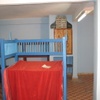Disclaimer
This entry contains information known to us from a variety of sources but may not include all the information currently available. Please be in touch if you notice any inadvertent mistakes in our presentation or have additional knowledge or sources to share. Thank you.
Archive
Shrine of Habib Mizrahi at Ait Ourir, Morocco
Leaving Marrakesh heading southeast on the road to Ouarzazate, about 20 minutes into the drive, a faded whitewashed wall on the right side of the road appears with a cryptic spray-painted message: “Rabbi Habib.” The sign is half hidden behind an electric pole as well as by the regular traffic of donkeys that pass through the local village of Ait Ourir. The blue spray paint is a sign for pilgrims to turn off the paved highway and venture up a dirt road into the Atlas Mountains toward the grave of an esteemed rabbi.
Description
Rabbi El-Mizrahi: The winding road ends in front of a three-story complex that houses the shrine of Rabbi Habib El-Mizrahi (Habib the Easterner). By legend, the rabbi came from Israel many centuries ago as an emissary to the local population. Muslims, who also venerate the rabbi’s tomb, call him Mulay Tadot, the Master of the Acacia, after a tree that grows by the tomb.
Remote: For centuries the shrine was just a small hut. By some accounts, few visitors made the trek up the mountain to visit the tomb, which was tucked into the slope and had no formal marble tombstone. A Muslim man who lived nearby took care of the tomb and would bring water to those Jews who would ascend the mountain after shopping at the Tuesday market in the village below. ”What bad luck I have that the Jews don’t come to this saint,” the guardian is quoted as saying, “Otherwise I would be rich like the other pqidim [Muslim guardians]!”
Restoration: In recent years, however, David Ohayon, a member of the Marrakesh Jewish community, built a large terra cotta complex around the grave, providing guest rooms, full bathrooms, and a plaza to host the many pilgrims who visit the shrine for the rabbi’s hiloula – typically celebrated on the holiday Lag b’Omer. The regional governor even comes to welcome pilgrims, some of whom stay for an entire week.
Shrine of Habib Mizrahi
Cemetery: An old cemetery was recently discovered on the hill next to the shrine. A particularly heavy rainy season caused mudslides on the hill, revealing dozens of Jewish graves that had been obscured underneath layers of dirt and forgotten. The site is believed to be hundreds of years old. Many of the old graves have been restored by David Ohayon, and now have been outfitted with a slot on the end for placing memorial candles. It is believed that many more graves remain on the hill underneath mud — burial sites themselves buried by the earth.
Complex: Rabbi El-Mizrahi’s grave is located on the first floor of the complex, with a photograph of Morocco’s king hanging over the entrance from the courtyard. About two dozen rooms fill out the remainder of the complex, including small bedrooms, larger common spaces with couches, and bathrooms with showers. The roof deck offers a stunning view of the surrounding hills.
Sources
"Shrine of Habib Mizrahi." Youtube video, 7:07, posted by "DiarnaInfo," July 31, 2009, https://www.youtube.com/watch?v=uZBBSyJnOP4.






![Habib Mizrahi Shrine, Cemetery [2] (Ait Ourir, Morocco, 2010)](https://cdn.filestackcontent.com/cZUQH83SRBKYGmAmOQPv/convert?w=100&h=100&fit=crop)
![Habib Mizrahi Shrine, Cemetery [1] (Ait Ourir, Morocco, 2010)](https://cdn.filestackcontent.com/Pr7jwpTQpWm75PDsbDYw/convert?w=100&h=100&fit=crop)
![Wall Graffiti Along Road Near Habib Mizrahi Shrine [2] (Ait Ourir, Morocco, 2010)](https://cdn.filestackcontent.com/PxuD0N17Rlq51Dd1MHtd/convert?w=100&h=100&fit=crop)
![Wall Graffiti Along Road Near Habib Mizrahi Shrine [1] (Ait Ourir, Morocco, 2010)](https://cdn.filestackcontent.com/OZ6PkP7yQYzpHiSvG4km/convert?w=100&h=100&fit=crop)